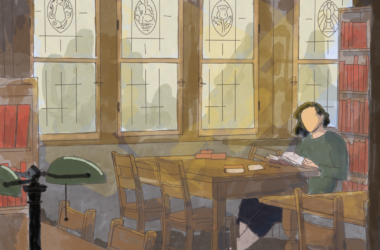 See footnote.
See footnote.Our environment has a deep impact on our mental, physical, and emotional health. A new exhibit at the Canadian Centre for Architecture (CCA) called Imperfect Health: The Medicalization of Architecture explores the numerous ways in which this truism has, and could, manifest itself in the arenas of structural and urban design.
Bring an open mind, curiosity, and a notebook. The variety of ideas present and the quality of their actualization, even in prototype, should tickle interested minds. Architecture students, epidemiologists, urban planners, medical historians, and design students (among others) will especially enjoy what Imperfect Health has to offer. Each instalment is unique, and all creative media are well-represented: photography, film, papercraft, architectural models, drawings, and the printed word. Each installation presents a unique angle on the exhibit’s broad questions of what constitutes a healthy or a sick space (whether that space is a home or an entire city), and how much, and in what ways, health considerations can and should inform our future design practices.
Aging, obesity, cancer, viral epidemics, and allergies are but some of the particular facets of health concerns which have been brought to our social attention especially after the modern marriage of medicine and architecture. Walk through the transparent arenas of the exhibit, partitioned only by glass, and discover past and future built solutions to these diseases, and others. We bring certain illnesses into our dwelling-places, but some of our dwelling-places contribute to our illness; Imperfect Health explores how we experience and might circumvent both eventualities by exploiting our capacity for creative architectural design.
The diversity of the exhibit material provides numerous departure-points for flights of imagination and discussion. Here there are building skins which gather air pollution into a fuzzy carpet of dust particles on their exteriors, saving our lungs (if not our sense of aesthetics); places where you can go deep underground into a salt mine or high into the alpine air to mend already ill lungs; buildings which integrate office space with vertical hydroponics; glimpses of under-used urban space where slowly waving trees peek from around stucco corners; life-sized paper livestock that remind us how large-scale factory farms have become animal cities of disease, and much more.
Be sure to take advantage of one of the CCA’s guided tours, as I did, for a comfortable introduction to the exhibit. You’ll have the opportunity to discuss each installation with your guide alongside your group of fellow visitors. This turns a simple tour into a seminar-style discussion which, during my visit, ended up being an enjoyable accompaniment to the exhibit itself.
Once you’ve enjoyed a tour, give yourself time in order to double back and explore the exhibits again more thoroughly. At a leisurely pace, the tour itself takes an hour, but still leaves a lot of in-depth reading and contemplation to be done at each installation. Or instead of doubling back, feel free to visit and spend more one-on-one time with the installations on a different day. With a student ID, admission is free.
Several public events will accompany the exhibition’s run, which aims to bring together experts and the public in a discussion about unique topics related to “the spatial and physical implications of health issues.” (The CCA website has further details.) A companion book will be published in spring 2012, edited by CCA curators Mirko Zardini and Giovanna Borasi, providing a new way to enjoy the ideas presented by Imperfect Health – from the comfort of your own couch.
With its rich menu of ideas and their stylish, effective spatial presentation, Imperfect Health is an excellent thought-provoker and conversation-starter of an exhibit. While it might be tempting to put off a visit because of its long run, don’t wait. The questions raised in the corridors of this CCA exhibit are perfect to mull over while stuck indoors during the long winter that lies ahead.
The Canadian Centre for Architecture’s Imperfect Health runs until April 1 at 1920 Rue Baile.
Photo Copyright: Conceptual design model for Imperfect Health: the Medicalization of Architecture, Canadian Centre for Architecture, 2011. © Office Kersten Geers David Van Severen, Brussels, Belgium.








